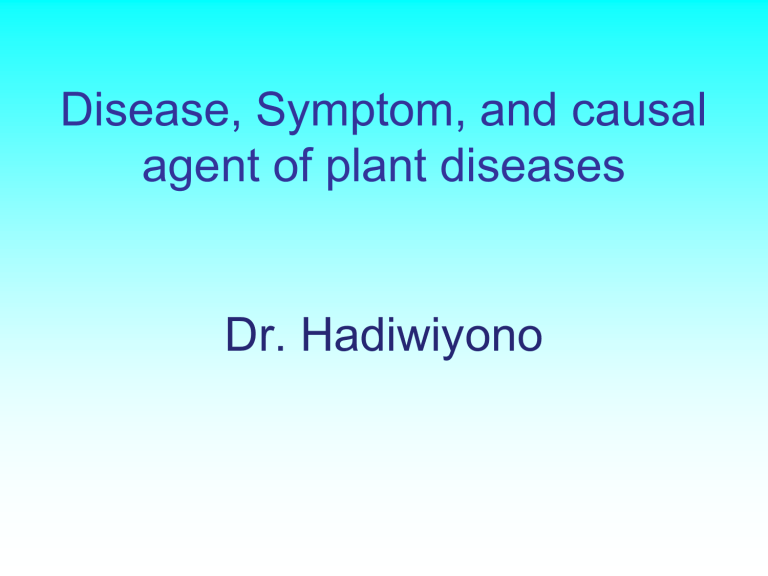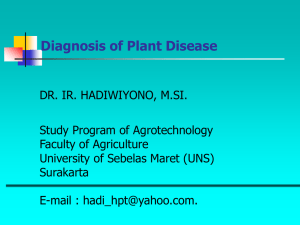Disease - rajabillah
advertisement

Disease, Symptom, and causal agent of plant diseases Dr. Hadiwiyono Schematic representation of the basic function in a plant (left) and the interference with this function (right) caused by general type of disease PLANT DISEAE CONCEPT Disease • “Any malfunctioning of host cells and tissues that results from continues irritation by a pathogen or environmental factor and leads to development to symptom (Agrios, 2005)” • Adanya sel dan jaringan inang yang malfungsi sebagai akibat dari iritasi yang terus-menerus oleh suatu agens patogen atau faktor lingkungan dan mengarah pada berkembangnya gejala • What is the healthy plant? Disease based on the causal agents • Infectious disease = pathogenic disease = parasitic disease = parasite disease = biotic disease • non-infectious disease = non pathogenic disease = non parasitic disease = non parasite disease = physiologic disease = abiotic disease Terminology Pathogen: organism-causal agents of disease Parasite: organism life in/on other organism. Facultative Parasite: saprophyte being bale to life as parasite. Obligative parasite: just life as parasite or true parasite Fisiopat, physiopath: causer from abiotic factors Saprofit, saprophyte: organism life in/on organism residue or debries. Obligative saprophyte: true saprophyte or jast life as saphrophyte Inang, Host: organism where the parasite or pathogen life. Perentan, Suscept: host of pathogen and condicuve to establish a disease. Rentan, susceptible: host character by which the disease to be conduce for disease occur><tahan, resistant. Terminology( continued ) Toleran, tolerant: suitable as host but the disease is very mild Patogenisitas, pathogenisity: capability of parasitic organism as pathogen Virulensi, keganasan, virulence: capability of pathogen to produce the disease Nekrotrof, necrotroph: parasite by which life and obtain their food from dead tissue Biotrof, biotroph: parasite by which life and obtain their food from life tissue DISEASE SYMPTOM Symptoms: “are the expressions by suscept or host of a pathogenic condition by which a particular plant disease may be distinguished from other diseases” (Ilag, 1987). • Adalah kenampakan perentan atau inang dari suatu keadaan patogenik sehingga suatu penyakit tertentu dapat dibedakan dari penyakit lain Based on the type of symptom: 1. Hyperplasic; hypertrophic hyper=high, too plastic= change troph = growth 2. Hypoplastic; hypotrophic hypo= low, lack 3. Necrotic and necrotrophic Necrotic= dead or killing tissue Hyperplastic Symptom: Club root caused by Plasmodiophora brassicae on cabbage hiperplastic Wilting sysmptom Spore of pathogen Hiperplastic Root knot nematode damage to tomato in the fields Root-knot nematode-affected root system on left, healthy on right. Galls on tomato roots caused by Rootknot Meloidogyne spp. Roots of a legume. Nitrogenfixing nodules are attached only to the sides of roots. Hyperplastic Crown gall of Mark apple rootstock (Courtesy A.L. Jones). Crown gall tumour on an elm tree. Crown gall symptoms on organically grown tomato (cv. Dometica) Hipoplastic, Banana bunchy to virus Hypoplastic: RICE GRASSY STUNT VIRUS Hipoplastik: Tomato Stunted Curly Top Virus Mosaic Virus symptoms on Rose Pea enation mosaic virus Hypoplastic Aple mosaic virus Strawberry mottle virus Maize chlorotic mottle virus Bean pod mottle virus on soybean Hypo-Hyperplastic Oak leaf blister caused by Taphrina caerulescens Hyperplasic Tea leaf blister caused by Exobasidium vexans Symptom of basal rot of garlic cased by F.o. fsp. cepae Necrotic symptom Symptom and conidia of Alterneria porrii on Nekrotic A. Gejala bercak ungu (purple spot) of leek; B. Conidia under stereo microscope; C. Conidia under compound mikrosocpe Necrotic symptom Leaf rot of petsai caused Rhizoctonia solani Setae of acervulli Necrotic: Anthracnose on avocado caused by Colletotrichum gloeosporioides Necrotic: leaf spot of cabbage caused by Alternaria brassicae Nekrotic leaf blight, Phytophthora infestan of tomato is also referred to as buckeye rot because of the characteristic lesions on the fruit. Algal leaf spot (red rust) on mango and many other tropical fruit crops is caused by the green alga, Cephaleuros virescens. The algal thallus is orange to rust colored and develops below the host cuticle under wet conditions. SPICIFIC SYMPTOM 1. 2. 3. 4. 5. 6. 7. Kelayuan, wilting Etiolasi, etiolation Klorosis, chlorosis Mosaik, mosaic Belang, mottling Pemucatan urat daun, Vein clearing Penggelapan urat daun, Vein banding 8. Pembusukan, rotting 9. Bercak, spot 10. Hawar, blight 11. Lobang tembak, Shot hole 12. Kanker, cancer 13. Pemumian, mummification 14. Mati pucuk, die-back 15. Roset, Rosetting 16. Peruntuhan, Abscission 17. Keriting, Curling 18.Kudis, Scab 19.Bergaris, Streak or stripe 20.Kerdil, Stunting 21.Rebah semai, damping off 22.Fasiasi, fasciation 23.Blast 24.Karat, rust 25.Pustul, Pustule 26.Kalus, Callus 27.Salah bentuk, Malformation 28.Tilosis, tylosis 29. Puru, Gall 30.Filodi, phylody 31.Sarkodi, Sarcody 32.EmbunTepung, powdery mildew 33.Embun upas, Donwny mildew 34.Antrak, antractnose 35.Cacar, blister Specific symptom caused by some virus A B C A. cucumber mozaic virus on lettuce, B. Beet yellow stunt virus on crisphead lettuce (Davis et al. 2002), C. Zucchini yellow mozaic virus pada Summer squash (Zitter et al.,1998) Examples of symptom caused by toxic herbicide being like symptom caused by virus A. Leaf of squash is damaged by 2,4-D, B. Glyphosate Examples of symptom caused by mites being like symptom caused by virus A. Symptom of cucumber leaf attacked by spider mites, B. Spider mites, Tetranychus sp. DISEASE SIGN Pathogen structure associating cell, tissue, organ of infected plant As indicator of the disease where the infection occur on/in the cell, tissue, organ of infected plant Some disease signs need microscopic observation Disease sign and specific structure Sclerotium rolsii Whitish myselia and Sclerotia looking the seed of brasicae Disease sign of blood disease of banana a a. b. c. d. b-1 b-2 c d Ooze coming out from vascular system of dipped tissues, Fogy water after shaking the dipped tissues Ooze exuded from cross section of banana peduncle Ooze exuded by the bract of banana flower Disease sign- bacterial ooze coming out from the vascular system B A A. Sticky strand test on cut stem with bacterial streaming (oozing) from xylem vessels of melon infected Ervinia tracheiphila, causing bacterial wilt B. Oozing test , showing bacterial mass coming out from vascular tissue Disease sign: specific structure of virus in infected tissue • Potyviridae producing ‘pinwheel’ inclusions Powdery mildew on Oak leaf Powdery mildew on melon caused by Erysiphe cichoracearum Assignment I: explain what type of the symptoms and give a sample of each. Do with hand writing! 1. 2. 3. 4. 5. 6. 7. Kelayuan, wilting Etiolasi, etiolation Klorosis, chlorosis Mosaik, mosaic Belang, mottling Pemucatan urat daun, Vein clearing Penggelapan urat daun, Vein banding 8. Pembusukan, rotting 9. Bercak, spot 10. Hawar, blight 11. Lobang tembak, Shot hole 12. Kanker, cancer 13. Pemumian, mummification 14. Mati pucuk, die-back 15. Roset, Rosetting 16. Peruntuhan, Abscission 17. Keriting, Curling 18.Kudis, Scab 19.Bergaris, Streak or stripe 20.Kerdil, Stunting 21.Rebah semai, damping off 22.Fasiasi, fasciation 23.Blast 24.Karat, rust 25.Pustul, Pustule 26.Kalus, Callus 27.Salah bentuk, Malformation 28.Tilosis, tylosis 29. Puru, Gall 30.Filodi, phylody 31.Sarkodi, Sarcody 32.EmbunTepung, powdery mildew 33.Embun upas, Donwny mildew 34.Antrak, antractnose 35.Cacar, blister









